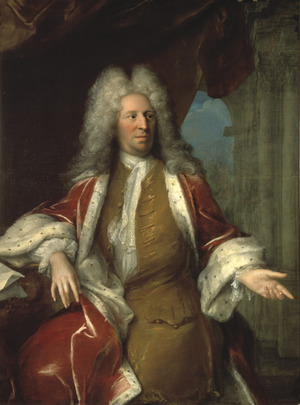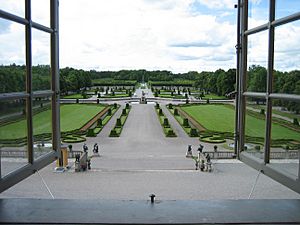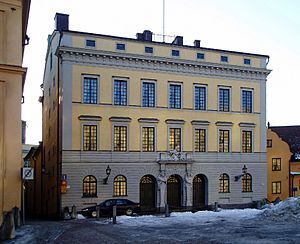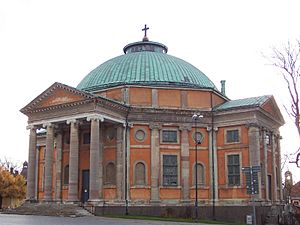Nicodemus Tessin the Younger facts for kids
Quick facts for kids
Nicodemus Tessin the Younger
|
|
|---|---|

Portrait by Georg Desmarées, 1723
|
|
| Born | 23 May 1654 |
| Died | 10 April 1728 (aged 73) |
| Nationality | Swedish |
| Occupation | Architect |
| Buildings | Drottningholm Palace Stockholm Palace Tessin Palace |
Count Nicodemus Tessin the Younger (born May 23, 1654 – died April 10, 1728) was a famous Swedish architect. He was known for designing buildings in the Baroque style. He also worked as a city planner and helped manage important projects for the Swedish government.
Nicodemus Tessin the Younger was part of an important family of architects. His father was Nicodemus Tessin the Elder, and his son was Carl Gustaf Tessin. This family had a big impact on Swedish architecture and history for many years.
Contents
Biography
Early Life and Education
Nicodemus Tessin the Younger was born on May 23, 1654, in Nyköping, Sweden. He was the only child of Nicodemus Tessin the Elder, who was also a famous architect. His mother was Maria Svan.
From a young age, Nicodemus showed a talent for art. He studied Mathematics and languages at Uppsala University. There, he was likely influenced by Olaus Rudbeck, who was very interested in the science behind architecture.
Travels and Learning
In 1673, when he was 19, Nicodemus traveled to Italy. He went to Rome with an important messenger from Queen Christina of Sweden. In Rome, he had the chance to learn from the best architects of that time. These included Carlo Fontana and Gian Lorenzo Bernini. Studying their work and ancient Roman buildings greatly influenced Tessin.
After four years, he returned to Sweden. But King Charles XI of Sweden immediately sent him on another trip. This journey, from 1677 to 1678, took him to England and France. There, he learned from architects like André Le Nôtre and Jean Bérain. Their ideas deeply affected his later designs for decorations and gardens.
In 1687-1688, he traveled again to Rome. He returned to Sweden through Austria and Germany. During his travels, he wrote detailed notes in a diary about the buildings he saw. Tessin also worked closely with his father and his stepbrother, Abraham Winands. When his father passed away, Tessin shared his position with Winands until Winands died in 1709.
Work as an Architect
When Tessin the Elder came to Stockholm, Sweden was a powerful country in Europe. Rich noble families had enough money to build grand buildings. However, this changed with something called the "Reduction." This was when the Swedish government took back land and money from the nobles. This meant nobles had less money for big building projects. Instead, highly educated government officials, like the Tessin family, became more important.
Nicodemus Tessin the Elder became a lesser noble in 1674. Nicodemus Tessin the Younger became a count in 1714. Because of the Reduction, Tessin the Younger had fewer jobs from nobles. His main clients became the church and the royal family. Queen Hedvig Elenora gave him many important projects, including ambitious palaces and gardens.
In the late 1680s, King Charles XI of Sweden asked Tessin to update the northern part of the Stockholm Palace. This gave Tessin a chance to go on another study trip. He visited the Netherlands, France, and Italy. This time, he was very respected across Europe. He proudly told how King Louis XIV of France made the fountains at the Versailles Palace play just for his visit. This honor was usually only given to foreign princes.
During this trip, Tessin met Daniel Cronström. Cronström became a very important helper and contact for Tessin in Europe. Tessin's projects in Sweden often needed him to work with builders and artists from other countries. Their letters to each other have been very helpful for historians studying Tessin's work.
When Tessin returned, he immediately started working on the royal palace. By 1695, he finished the grand northern Baroque style front of the palace. It was inspired by Gian Lorenzo Bernini's design for the Louvre in Paris. Plans to update the rest of the palace stopped when the king died. Then, in 1697, the palace was destroyed by a fire.
The day after the fire, Tessin was asked to create plans for a new palace. He quickly made a design that pleased the young King Charles XII of Sweden and his regents. However, in 1700, Charles XII left Sweden for long military campaigns. Work on the palace slowed down. After a big defeat in the Battle of Poltava in 1709, work almost stopped completely. Even though Tessin spent much of his later life drawing detailed plans for the palace, it was not finished by the time he died.
In 1690, Tessin married his girlfriend, Hedvig Eleonora Stenbock. She was a lady-in-waiting to Queen Hedvig Elenora. At this time, Tessin was still a lesser noble. Marrying a woman from a higher noble family was seen as unusual. So, they had to get married secretly in Pomerania. To fix the situation, Tessin needed to build a home that matched his wife's high status.
Work on the Tessin Palace began in 1694. It started slowly, but by 1697, Tessin and his family could move in. In 1701, two years after Tessin became a high noble, the inside of the palace was finished. He was then able to invite the widowed queen and the royal family for dinner. Besides his own palace, the gardens of the Drottningholm Palace and Steninge Palace are considered some of his greatest achievements. Both are located near Stockholm.
Later Life and Administration
Most of Tessin's architectural designs were created in the late 1600s. These included several churches, such as King Charles' Church in Kungsör and the Holy Trinity Church in Karlskrona. Many of his proposed designs were never actually built. In his later life, he played an important role as an administrator. He also created detailed city plans for Stockholm, connected to his work on the royal palace.
Family
- Nicodemus Tessin the Younger was the father of Carl Gustaf Tessin. Carl Gustaf became one of the most important Swedish politicians of his time.
- Carl Erik Tessin
- Hedvig Tessin von Schwerin
- Ulrika Maria Tessin Sparre, who was the mother of Fredrik Sparre. Fredrik Sparre was a very important government official in Sweden in the 1790s.
Selected Works
- Stockholm Palace
- Tessin Palace, built between 1694 and 1700
- Steninge Palace
- Completion of the Drottningholm Palace
- Gottorp, in Schleswig, built between 1697 and 1703
- Holy Trinity Church, Karlskrona
- King Charles' Church, Kungsör
- Västra/Östra boställshuset, Stockholm
See also
 In Spanish: Nicodemus Tessin el Joven para niños
In Spanish: Nicodemus Tessin el Joven para niños





